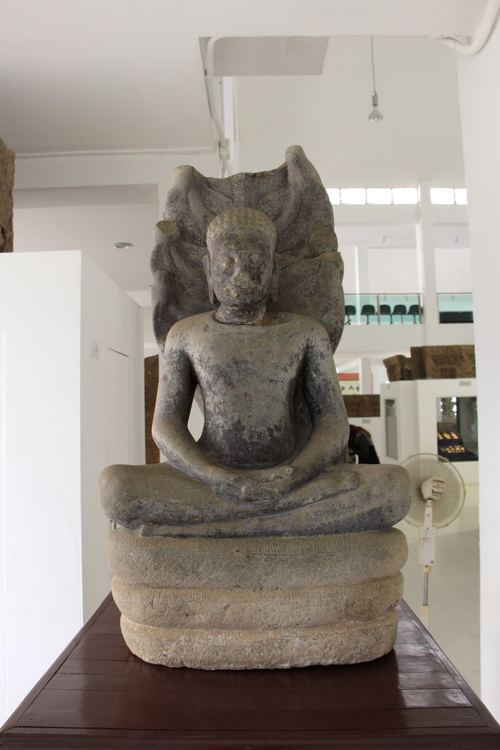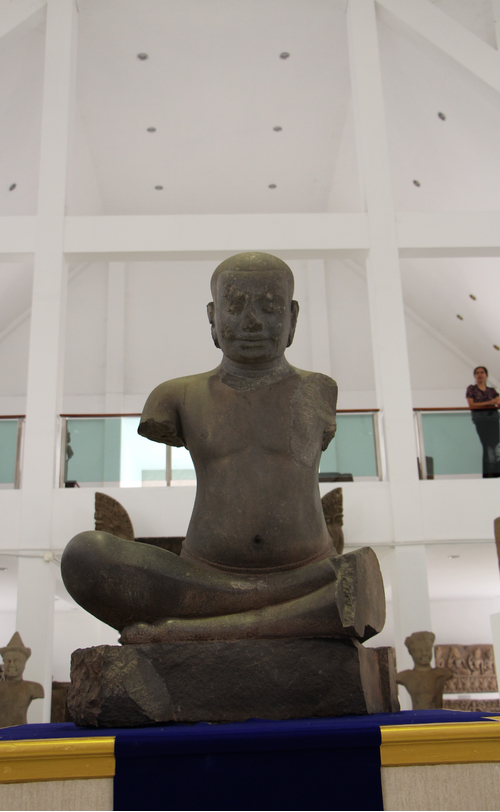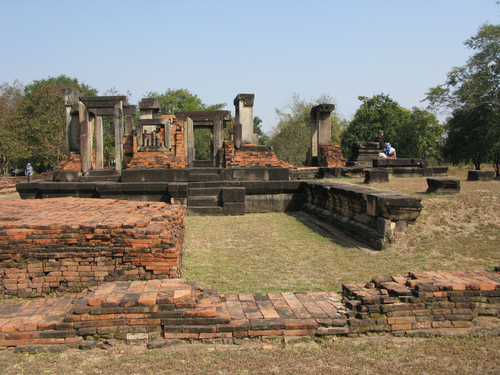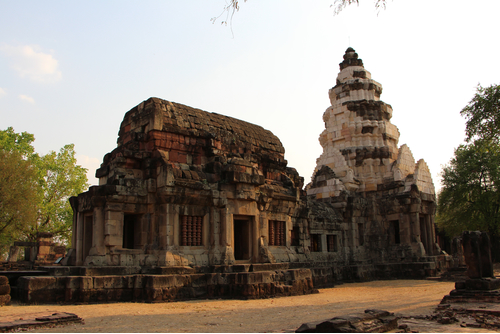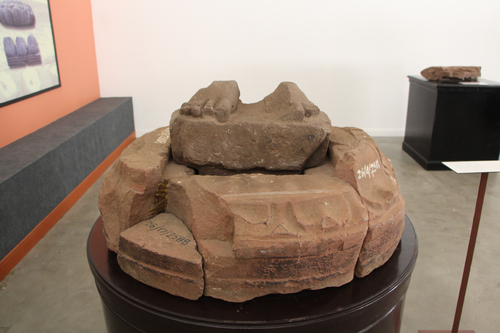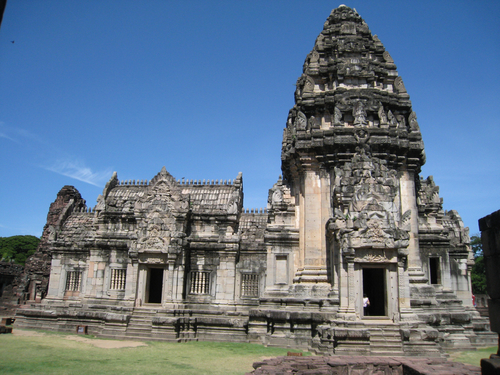ค้นหางานศิลปกรรม
ฐานข้อมูลศิลปกรรมในเอเชียตะวันออกเฉียงใต้
ประติมากรรมพระพุทธรูปนาคปรก
พระพุทธรูปอยู่ในอิริยาบถนั่งทำปางสมาธิ ขัดสมาธิราบ พระชงฆ์คมเป็นสันดังมนุษย์จริง ครองจีวรห่มเฉียง บางแนบพระวรกาย ไม่มีริ้ว พระพักตร์สงบ พระเนตรปิด แย้มพระโอษฐ์เล็กน้อย ขมวดพระเกศาเวียนเป็นวงก้นหอย พระอุษณีษะนูนเพียงเล็กน้อย ขนดนาคที่รองรับพระพุทธเจ้ามี 3 ขนด มีพังพานนาคหลายเศียรปกอยู่ทางด้านหลัง
ประติมากรรมพระเจ้าชัยวรมันที่ 7
ประติมากรรมฉลองพระองค์พระเจ้าชัยวรมันที่ 7 มีสภาพชำรุดบางส่วน พระกรทั้งสองข้างและพระชานุซ้ายหักหายไป พระพักตร์เหลี่ยม พระเนตรปิด แย้มพระโอษฐ์เล็กน้อย พระเกศายาวเกล้าเป็นมวย พระวรกายท้วม ช่วงบนไม่ทรงอาภรณ์ใดๆ ช่วงล่างทรงสมพตสั้น นั่งอยู่ในอิริยาบถขัดสมาธิ พระหัตถ์ที่หักหายไม่ทราบว่าทำท่าทางใด แต่บางท่านสันนิษฐานว่าประนมกรไว้ เพราะหากทำท่าสมาธิหรือวางบนพระเพลาจำต้องเห็นร่องรอยของฝ่าพระหัตถ์ที่ติดอยู่กับพระเพลา
สถาปัตยกรรมปราสาทเมืองแขก
ปราสาทเมืองแขกมีขนาดค่อนข้างใหญ่ ก่อด้วยหินทรายและอิฐ แผนผังเป็นรูปสี่เหลี่ยมผืนผ้า หันหน้าไปทางทิศเหนือ สิ่งก่อสร้างสำคัญได้แก่ ปราสาทประธาน บรรณาลัย 2 หลัง ระเบียงคด ซุ้มประตูหรือโคปุระ กำแพงแก้ว สระน้ำ และปราสาทก่อด้วยอิฐขนาดเล็กลักษณะผังโบราณสถานแบ่งออกได้เป็น 3 ส่วน คือส่วนที่ 1 หรือส่วนในสุด ประกอบด้วยปราสาท 3 หลัง ก่อด้วยหินทรายและอิฐตั้งอยู่บนฐานเดียวกัน หัวหน้าไปทางทิศเหนือ เฉพาะองค์ปรางค์หรือปราสาทประธานมีมุขหรือมณฑปซึ่งมีลักษณะเป็นห้องต่อออกมาทางด้านหน้า มีบันไดขึ้นทั้งด้านหน้าและด้านข้างทั้ง 2 ข้าง พบฐานประติมากรรมหินทรายที่ครรภคฤหะของปราสาทประธานและปราสาทหลังด้านทิศตะวันออก อาคารทั้งสามหลังเหลือเพียงเฉพาะส่วนฐานและตัวอาคารบางส่วน รวมทั้งที่ปราสาทประธานยังคงหลงเหลือช่องหน้าต่างและลูกมะหวด เสาประดับกรอบประตู กรอบประตูหินทราย และทับหลังสลักภาพนารายณ์บรรทมสินธุ์ที่ด้านบนกรอบประตูหน้าสุดหรือส่วนมณฑปด้านข้างองค์ปรางค์ประธานมีฐานอาคารก่อด้วยอิฐ 2 หลัง อยู่ด้านซ้ายและขวาด้านละ 1 หลัง หันด้านหน้าเข้าสู่ปราสาทประธาน อาจเป็นวิหารหรือบรรณาลัย ในส่วนแรกนี้มีกำแพงแก้วก่อด้วยอิฐล้อมรอบ ทางด้านทิศตะวันออกของกำแพงมีอาคารอิฐผังสี่เหลี่ยมผืนผ้าก่อขนานยาวไปกับกำแพง อาคารหลังนี้มีประตูเข้าออกอยู่ด้านทิศตะวันตกและทิศเหนือ ยังคงหลงเหลือเสาประดับกรอบประตูอยู่ที่ประตูด้านทิศเหนือมีซุ้มประตูทางเข้าหรือโคปุระชั้นในอยู่ด้านเดียวคือด้านหน้าหรือด้านทิศเหนือ (มีช่องประตู 3 ช่อง) ที่ยังคงหลงเหลือกรอบประตูและเสาประดับกรอบประตูหินทราย นอกจากนี้ยังปรากฏฐานอาคารก่อด้วยอิฐอีก 2 หลังที่มุมกำแพงแก้วด้านหน้าของปราสาทประธาน ข้างโคปุระหรือซุ้มประตูชั้นในด้านหน้าหรือด้านทิศเหนือทั้ง 2 ด้าน ซ้ายและขวา โดยอาคารด้านขวามีทางเดินปูอิฐเชื่อมกับอาคารยาวที่ขนานไปกับกำแพงแก้วด้านทิศตะวันออกส่วนที่ 2 เป็นกำแพงชั้นนอก ซึ่งขุดเป็นสระเกือบจะล้อมรอบโบราณสถาน เว้นเพียงส่วนกลางด้านหน้า โดยใช้ดินที่ได้จากการขุดสระทำเป็นคันกำแพงล้อมรอบกำแพงแก้วและสระน้ำ ทางด้านทิศเหนือมีทางเดินเชื่อมกับส่วนในหรือส่วนที่หนึ่ง กำแพงชั้นนอกด้านหน้าหรือด้านทิศเหนือมีซุ้มประตูขนาดใหญ่หรือโคปุระชั้นนอกรูปกากบาท ตรงกับโคปุระชั้นใน (มีช่องประตู 3 ช่อง) ยังคงปรากฏช่องหน้าต่างและลูกมะหวดรวมทั้งกรอบประตูหินทรายส่วนที่ 3 อยู่นอกกำแพงชั้นนอกหรือส่วนที่สองออกมาทางด้านหน้าหรือด้านทิศเหนือ มีฐานอาคารก่อด้วยฐานก่อด้วยศิลาแลง หินทราย และอิฐ 2 หลัง ด้านซ้ายและขวาด้านละ 1 หลัง หันหน้าเข้าหากัน (อาคารหลังด้านขวาหันหน้าไปทางทิศตะวันตก ส่วนอาคารหลังด้านซ้ายหันหน้าไปทางทิศตะวันออก) ส่วนบนอาจจะสร้างด้วยไม้ ฐานอาคารทั้งสองหลังมีผังเป็นสี่เหลี่ยมมีมุขยื่นมาทางด้านหน้า ฐานสูง มีบันไดขึ้นสู่ด้านบนของฐานทั้ง 4 ด้าน มีกำแพงล้อมรอบ มีโคปุระที่ด้านหน้าและหลัง (ด้านหน้ามีขนาดใหญ่กว่า) ภายในห้องประธานของอาคารหลังด้านทิศตะวันตกมีฐานศิวลึงค์และโยนีหินทรายตั้งอยู่กลางห้อง เช่นเดียวกับอาคารหลังด้านทิศตะวันออกที่มีฐานประติมากรรมหินทรายตั้งอยู่กลางห้องประธาน จากการขุดค้นที่พบหลักฐานสำคัญ เช่น ศิวลึงค์ ฐานศิวลึงค์ หน้าบันสลักภาพอุมามเหศวร ทับหลังภาพพระอินทร์ทรงช้างเอราวัณ ทับหลังรูปพระนารายณ์บรรทมสินธุ์ ทับหลังรูปเทวดาประทับนั่งในซุ้มเหนือหน้ากาล ประติมากรรมโคนนทิ และจารึก 3 หลัก ทำให้สันนิษฐานได้ว่าศาสนสถานหลังนี้สร้างขึ้นเนื่องในศาสนาพราหมณ์ไศวนิกาย อายุราวปลายพุทธศตวรรษที่ 15 ถึงต้นพุทธศตวรรษที่ 16 ในศิลปะร่วมแบบเกาะแกร์-แปรรูป ส่วนจารึกระบุมหาศักราช 896 ตรงกับ พ.ศ.1517
สถาปัตยกรรมปราสาทพนมวัน
อยู่ในแผนผังสี่เหลี่ยมจัตุรัสหันหน้าไปทางทิศตะวันออก กลุ่มปราสาทประธานประกอบด้วยตัวปราสาทประธาน อันตราละ และมณฑปตั้งอยู่บนฐานเดียวกันปราสาทประธานมีแผนผังเป็นรูปสี่เหลี่ยมจัตุรัสออกมุม มีซุ้มมุขและประตูทางเข้าทั้งสี่ทิศ โดยมีมุขทางเข้าด้านทิศตะวันออกเชื่อมต่อกับอันตราละคือฉนวนหรือมุขกระสันซึ่งทำเป็นทางผ่านไปยังมณฑปที่อยู่ทางด้านหน้า มณฑปนั้นมีแผนผังเป็นรูปสี่เหลี่ยมผืนผ้า มีประตูทางเข้าทั้งสี่ทิศเช่นเดียวกับปราสาทประธาน และมีหลังคาเป็นรูปโค้งทรงประทุน ทั้งหมดนี้ล้อมรอบด้วยแนวระเบียงคดซึ่งมีโคปุระหรือซุ้มประตูอยู่ทั้ง 4 ทิศ แต่ละมุมทั้ง 4 ของระเบียงคดยังปรากฏซุ้มทิศขนาดเล็กทรงสี่เหลี่ยมออกมุมมีประตูทางเข้าและประตูที่เชื่อมต่อกับปีกโคปุระทั้ง 2 ด้านส่วนทางทิศใต้ของปราสาทประธานในเขตระเบียงคดมีปราสาทขนาดย่อมลงมาเรียกกันว่าปรางค์น้อย มีผังแบบเพิ่มมุม ส่วนฐานก่อด้วยศิลาแลง แต่ส่วนของเรือนธาตุก่อด้วยหินทราย มีประตูทางเข้าออกทางทิศตะวันออกเพียงด้านเดียว ด้านที่เหลือเป็นประตูหลอก ปัจจุบันส่วนยอดได้พังทลายลงมาแล้ว องค์ปราสาทยังไม่มีการสลักลวดลายตกแต่งลงไปเป็นเพียงโครงสร้างรูปปราสาทเท่านั้น จากลักษณะดังกล่าวข้างต้นสันนิษฐานว่าปรางค์น้อยนี้น่าจะมีอายุอยู่ในช่วงพุทธศตวรรษที่ 16 เป็นต้นมา ภายในยังเป็นที่ประดิษฐานรอยพระพุทธบาทหินทราย นอกจากนี้ภายในระเบียงคดยังพบแนวฐานอาคารอิฐหลายหลังอยู่ล้อมรอบปราสาทประธานอีกด้วย
จิตรกรรมภาพเขียนสีก่อนประวัติศาสตร์เขาจันทน์งาม
ภาพเขียนสีทั้งหมดเขียนด้วยสีแดง อยู่สูงจากพื้นดินประมาณ 2-4 เมตร การศึกษาที่ผ่านมาของกรมศิลปากรและมหาวิทยาลัยศิลปากรได้จัดแบ่งภาพเขียนสีที่พบเป็น 12 กลุ่มตามตำแหน่งที่พบ โดยรวมแล้วมีภาพทั้งหมด 44 ภาพ เป็นภาพคน 32 ภาพ ภาพสัตว์ 5 ภาพ (สุนัข นกหรือไก่ ตะกวด? เม่น? เสือ?) คันธนูและลูกศร 1 ภาพ และไม่ทราบว่าเป็นภาพชนิดใด 5 ภาพ เทคนิคการเขียนภาพมี 2 แบบ คือ ภาพเงาทึบและลายเส้นโครงร่างภายนอก ภาพคนส่วนใหญ่มีส่วนน่องโต มีผ้านุ่ง ไม่สวมเสื้อ ผู้หญิงจะมีหางนกห้อยมาจากกระเบนเหน็บและพู่ประทับบนหัวกลุ่มที่ 1 เป็นภาพชุดที่เด่นและสำคัญที่สุด อยู่บนผนังหินด้านทิศตะวันออก เนื้อที่ขนาด 1x2 เมตร เป็นภาพเขียนแบบเงาทึบ ภาพมี 2 แถว (บนและล่าง) ลักษณะเป็นรูปกลุ่มคน 14 คน มีทั้งเพศชายและหญิง วัยเด็กและผู้ใหญ่ รวมทั้งภาพสุนัข 1 ตัว โดยมีรายละเอียดคือแถวบน เป็นภาพคน 3 คน คนแรกมีเพียงครึ่งซีก ไม่มีหัว คนที่ 2 ยืนกางแขน มีผ้ากางออกมาจากส่วนเอวทั้ง 2 ข้าง ชายผ้ามีแฉกเป็นริ้วๆ เป็นภาพที่เขียนด้านตรง แต่หันหน้าเอียงไปทางขวา คนที่ 3 เขียนให้เห็นด้านข้าง หันหน้าไปทางตรงกันข้ามกับคนที่ 2 ภาพนี้ไม่เต็มรูป ขาดส่วนคอ ลำตัวบางส่วน และต้นขาแถวล่าง เป็นขบวนภาพคนเดินเรียงเป็นแถว ภาพแรกของแถวล่างอยู่ต่ำจากแถวบนประมาณ 30 เซนติเมตร เป็นภาพคนยืนถือธนูในท่าทางกำลังยิงธนู โดยลูกธนูถูกยิงออกจากคันธนูแล้ว ภาพนี้เป็นภาพเขียนให้เห็นด้านข้าง มีเส้นผมอยู่บนหัว นุ่งผ้าห้อยหน้าหลัง ชายผ้าด้านนอกมีแฉกเป็นริ้วๆ ขาด้านหลังสลับเลื่อนไป ต่อจากภาพนี้เป็นภาพสุนัข หูตั้ง หางดาบ มีอวัยวะเพศบ่งบอกว่าเป็นตัวผู้ ลักษณะตัวผอมยาว ต่ำจากภาพสุนัขลงมาเล็กน้อยเป็นภาพคนนั่งชันเข่า คนที่ 2 เป็นภาพผู้หญิงมีท้องใหญ่ เปลือยอก มีหางคล้ายหางนก ภาพ 2 คนนี้อยู่ในลักษณะที่กำลังเล่นหรือคุยกัน คนหนึ่งเป็นผู้ชาย คนหนึ่งเป็นผู้หญิง ภาพถัดไปเป็นภาพคนยืนเท้าเอว นุ่งผ้า 2 ชิ้นหน้าหลัง แขนขวายกตั้งศอก เป็นภาพเขียนด้านข้าง ห่างจากภาพนี้ไปประมาณ 20 เซนติเมตร เป็นภาพคนยืนหลังค่อม บนหัวมีเส้นผม นุ่งผ้า 2 ชิ้นหน้าหลัง ชายผ้าด้านหน้ามีแฉกเป็นริ้วๆ มือขวายื่นออกไปถือสิ่งของคล้ายไม้เท้า ข้างหน้าภาพนี้เป็นภาพคนยืนยกแขนทั้ง 2 ข้าง คล้ายอยู่ในท่ารำ ต้นขาด้านหลังขาดหายไป ภาพถัดไปเป็นภาพผู้หญิง เห็นด้านข้างในท่าร่ายรำ ข้างหน้าภาพผู้หญิงเป็นภาพคนยืนยื่นแขนออกไปข้างหน้า มีผ้าปิดหน้า หลังชายผ้ามีรูปกากบาท ภาพถัดไปเป็นภาพเด็ก 2 คน อยู่ในท่ารำ คนหนึ่งยกแขกนทั้ง 2 ข้างขึ้น อีกคนหนึ่งมือซ้ายเท้าเอว มีขวายกขึ้น นุ่งผ้า 2 ชิ้นปิดหน้าหลัง ภาพถัดไปเป็นภาพสีแดงจางๆกลุ่มที่ 2 อยู่บนผนังหินด้านทิศตะวันออกใกล้กับภาพกลุ่มที่ 1 แต่อยู่คนละผนังหิน มีภาพคนชดเจน 1 ภาพ เป็นภาพคนผมยาวกำลังวิ่งหรือรำ มองเหลียวหลัง จากเข่าลงไปถึงปลายเท้าขาดหายไป ผนังด้านนี้มีรองรอยของภาพเขียนสีอยู่แต่ลบเลือนไปหมด เห็นเพียงสีแดงเป็นแถบๆกลุ่มที่ 3 อยู่บนผนังหินด้านทิศตะวันออก เป็นภาพคนกำลังจับสัตว์เลื้อยคาน ลักษณะคล้ายสัตว์กิ้งก่า แย้ หรือตะกวด ห่างจากภาพคนเล็กน้อยมีลายเส้นคดไปมา 3 เส้นกลุ่มที่ 4 อยู่บนผนังหินด้านทิศตะวันออก เป็นภาพคน 3 คน ไม่มีศีรษะ แสดงท่าทางยืนมีคนนุ่งผ้าคล้ายกระโปรงสั้นเหนือเข่า 2 คนกลุ่มที่ 5 อยู่บนผนังหินด้านทิศตะวันตก ภาพคน 3 คน ยืนขนาบภาพสัตว์คล้ายเม่นหรือหมูป่า ใช้เทคนิคเขียนภาพ 2 แบบ คือ แบบโครงร่างภายนอกและแบบเงาทึบ ภาพสัตว์และคนยืนอยู่หน้าสัตว์เขียนแบบโครงร่างภายนอก ส่วนภาพเขียนแบบคล้ายคล้ายเงาทึบเป็นภาพคนอยู่ในท่าทางกำลังวิ่ง นุ่งผ้าปิดหน้าหลัง 1 ภาพกลุ่มที่ 6 ภาพคน 3 คน ภาพที่สมบูรณ์ที่สุดในกลุ่มนี้อยู่ตรงกลาง เป็นภาพคนกางแขน นุ่งผ้าปิดหน้าหลัง แต่ส่วนตั้งแต่เข่าลงไปขาดหายไป สันนิษฐานว่าเป็นท่าร่ายรำ อีก 2 คนภาพขาดหายไป โดยหายไปครึ่งตัว ตั้งแต่หัวถึงกลางตัว 1 ภาพ และจากสะโพกลงไป 1 ภาพกลุ่มที่ 7 เป็นภาพสัตว์ภาพเดียว รูปร่างค้ลายสิงโตหรือเสือ ข้างหน้าสัตว์มีสีแดงเป็นจุดๆ รวม 5 จุด เกิดจากสีบางส่วนขาดหายไปกลุ่มที่ 8 รูปคน 2 คน แสดงท่ารำ มีเพียงครึ่งตัวด้านบน ส่วนล่างขาดหายไปกลุ่มที่ 9 รูปคน 1 คน ยืนยกแขนส่วนปลายแขนกับขาขาดหายไป 1 ข้าง ด้านข้างคนมีลายเส้นวาดยาวตามแนวตั้ง อาจจะเป็นภาพคนที่ลบเลือนไป (?)กลุ่มที่ 10 รูปคน 1 คน ไม่มีศีรษะ อยู่ในลักษณะท่าทางคู้ตัวกลุ่มที่ 11 มีรูป 3 รูป อาจเป็นภาพคนทั้ง 3 รูป แต่ภาพลบเลือนขาดไป กลุ่มที่ 12 เป็นภาพคนครึ่งตัว แขนข้างขวากางออกจากลำตัว แขนซ้ายเยียดตรงขนานกับพื้น
ประติมากรรมพระพุทธรูปไสยาสน์
พระพุทธรูปสร้างโดยการนำเอาหินทรายขนาดใหญ่มาเรียงกันแล้วสลักเป็นพระพุทธรูป ประทับไสยาสน์แบบตะแคงขวาหรือสีหไสยาสน์ พระกรขวาวางราบกับพื้นรองรับพระเศียร พระวรกายเหยียวยาว พระกรซ้ายวางทับอยู่ด้านบน พระบาททั้ง 2 ข้างวางเสมอกัน พระพักตร์ทำจากหินทรายหลายก้อนมาเรียงซ้อนกัน มีรูปแบบทั่วไปตามศิลปะทวารวดี คือ พระพักตร์แลดูเหลี่ยม พระขนงเป็นสันและต่อเป็นปีกกา พระเนตรเหลือบต่ำและโปน พระนาสิกใหญ่ พระโอษฐ์แบะกว้าง
ประติมากรรมพระพุทธรูป
ชิ้นส่วนพระพุทธรูปหินทรายนี้เหลือเพียงพระบาทและฐานบัวเท่านั้น หินทรายส่วนพระบาทเป็นผังสี่เหลี่ยม สลักเชื่อมติดกับฐานหน้ากระดานและมีเดือยยาว ส่วนหินทรายส่วนฐานบัวเป็นผังกลม มีจารึกอยู่ที่ขอบล่าง กึ่งกลางฐานบัวสลักเป็นช่องสี่เหลี่ยมเพื่อรับพระบาท
สถาปัตยกรรมปราสาทประธานพิมาย
ปราสาทประธานหรือปรางค์ประธานสร้างจากหินทรายสีเทา หันหน้าไปทางทิศใต้ องค์ประกอบสำคัญได้แก่ เรือนธาตุอยู่ในผังเพิ่มมุม ด้านเหนือ ตะวันออก และตะวันตกของเรือนธาตุเป็นมุขทางเข้าสู่ครรภคฤหะที่อยู่ภายใน ส่วนด้านใต้เป็นอันตราละเชื่อมต่อกับมณฑปสี่เหลี่ยมผืนผ้า มีประตูทางเข้าสู่มณฑปทางด้านใต้ (ในอดีตทางด้านนี้น่าจะมีรูปเคารพ จึงไม่อาจเข้าไปภายในได้จริง) ตะวันออก และตะวันตก ประดับบราลีที่สันหลังคามุข อันตราละ และมณฑปหลังคาของเรือนธาตุเป็นชั้นซ้อนลดหลั่นกัน แต่ละชั้นจำลองย่อส่วนจากเรือนธาตุ ประดับด้วยบรรพแถลงและนาคปัก (กลีบขนุน) ยอดสุดเป็นกลศ นภศูลที่เคยมีอยู่พักหายไปแล้ว ห้องครรภคฤหะที่อยู่ในเรือนธาตุประดิษฐานพระพุทธรูปนาคปรกแบบายน จึงไม่ใช่องค์ดั้งเดิมที่ประดิษฐานพร้อมการสร้างปราสาทประธาน มีรางน้ำมนต์หรือท่อโสมสูตรไหลออกทางมุมทิศตะวันออกเฉียงเหนือ
